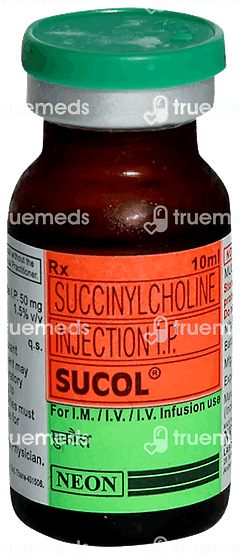Suxamethonium
Uses of Suxamethonium
Suxamethonium is primarily used to facilitate endotracheal intubation during general anaesthesia and is classified as a depolarising neuromuscular blocking agent.
It is also used to provide muscle relaxation during short surgical procedures, electroconvulsive therapy, and other medical procedures that require temporary paralysis.
Side effects of Suxamethonium
Muscle fasciculations
Postoperative muscle pain
Increased intraocular pressure
Transient hyperkalaemia
Malignant hyperthermia (rare)
How Suxamethonium works
Suxamethonium is a depolarising neuromuscular blocking agent.
It binds to acetylcholine receptors at the neuromuscular junction, causing initial muscle contractions followed by muscle relaxation. This sustained depolarization prevents further muscle contraction by inactivating the sodium channels essential for muscle fibre excitation.
Certified content
Written By

BDS, MDS
Reviewed By

BMS, FMC, MD Resident
Expert Advice
Dosage Forms Available
Suxamethonium is available as an injectable solution, designed for intravenous administration.
Age and Dose Restrictions
Suxamethonium is suitable for use in adults and paediatric patients, though dosages must be carefully calculated based on the patient's body weight.
Contraindications
This medicine is contraindicated in individuals with a known hypersensitivity to the medication.
It is also contraindicated for those with a personal or family history of malignant hyperthermia.
Individuals with pseudocholinesterase deficiency should not administer Suxamethonium.
Other Medications to Avoid
This medicine may interact with muscle relaxants (e.g., non-depolarizing neuromuscular blockers like vecuronium) and antibiotics (e.g., aminoglycosides like gentamicin). It may also interact with cholinesterase inhibitors (e.g., neostigmine) and anesthetics (e.g., inhalational anesthetics like halothane).
Overdose and Missed Dose
Chances for an overdose of this medicine are less as it is administered to you by a healthcare professional. An overdose of Suxamethonium may lead to prolonged muscle paralysis and respiratory depression. Immediate medical intervention is critical in managing overdose symptoms.
If you miss a dose, consult a healthcare provider.
Management of Side Effects
Most side effects are temporary and generally harmless and resolve when discontinuing this medicine. However, if you experience any severe side effects or worsening of any of the symptoms, please consult your doctor.
Muscle pain after administration can be managed by gentle exercise of the affected muscles if tolerable.
Increased saliva production can be managed by swallowing frequently or using tissues.
Use in Driving and Operating Machinery
Given its use exclusively in controlled medical environments like operation theatres, Suxamethonium does not directly impact tasks such as driving or operating machinery post-administration.
Use in Pregnancy and Lactation
Consult your doctor before using Suxamethonium if you are pregnant or breastfeeding. The decision to use this medicine should be made only if the benefits outweigh the risks.
Caution in Other Conditions
Caution is advised when using Suxamethonium in patients with conditions that affect plasma cholinesterase levels, such as liver disease or genetic disorders affecting enzyme production.
Patients with cardiovascular diseases should also be closely monitored due to the potential for fluctuations in heart rate and blood pressure during administration.
patients with cancer, tuberculosis, and tetanus should also exercise caution while administering this medicine.
Special Dietary and Lifestyle Recommendations
Since Suxamethonium is used during specific medical procedures, there are no ongoing dietary changes recommended.
Prior to undergoing surgery or specific medical procedures where Suxamethonium might be used, follow your doctor's advice regarding fasting or any specific preparation required.
Post-procedure, adhering to recommended dietary guidelines for recovery after anaesthesia can aid in overall wellness and quicker recuperation. This might include consuming light meals or increasing hydration.
Frequently asked questions
How does Suxamethonium work in the body?
Suxamethonium works by acting as an acetylcholine receptor agonist at the neuromuscular junction. It binds to and activates nicotinic acetylcholine receptors, causing depolarisation of the postsynaptic membrane. This results in muscle fasciculations followed by flaccid paralysis of skeletal muscles.
Can Suxamethonium cause allergic reactions?
Yes, Suxamethonium can cause allergic reactions in some individuals. If you have a known hypersensitivity to Suxamethonium, it should not be administered.
Does Suxamethonium affect fertility?
There is no evidence suggesting Suxamethonium affects fertility, as it is only used in short-term, controlled medical settings.
Does Suxamethonium impact mood or consciousness?
Suxamethonium does not impact mood or consciousness directly but is often used alongside anaesthetics, which do.
What precautions should be taken while administering Suxamethonium?
Suxamethonium should be used cautiously in patients with certain conditions such as burns, crush injuries, neuromuscular disorders, and hyperkalaemia. It should only be administered by trained medical professionals in settings equipped to handle potential complications.
How long does it take for Suxamethonium to work?
Suxamethonium acts rapidly, usually within 30 seconds to 1 minute, to cause muscle relaxation, with effects lasting a few minutes.
How should I store Suxamethonium?
Suxamethonium should be stored at controlled room temperature and protected from light and freezing. Any leftover or unused solution should be properly discarded, as per the manufacturer's guidelines.





Subscribe
Claim your complimentary health and fitness tips subscription and stay updated on our newest promotions.
Download Truemeds
Manage your health with ease Download Truemeds today!Get easy access to medicine refills, health information, and more. With our app, you'll never have to wait in line again. Download now and start taking control of your health.

Contact Us
Our customer representative team is available 7 days a week from 9 am - 9 pm.
v3.4.16
Our Payment Partners








